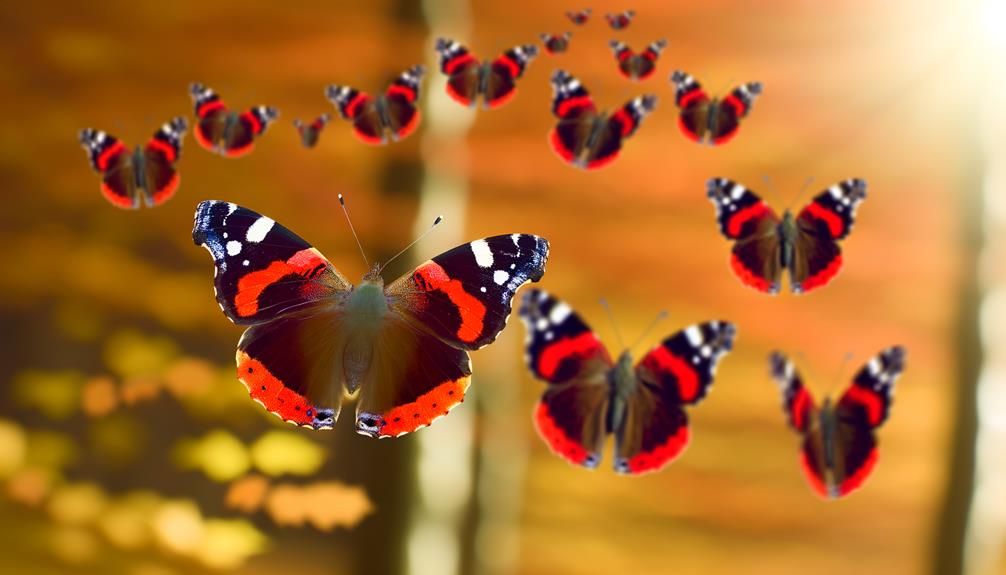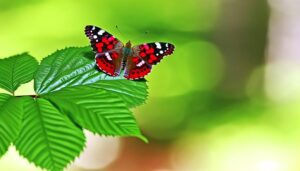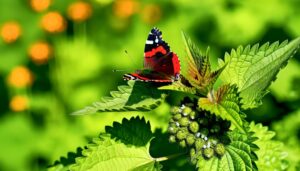Do Red Admiral Butterflies Hibernate in Winter?
Red Admiral butterflies (Vanessa atalanta) do not hibernate in the traditional sense but instead enter a state of diapause, greatly reducing their metabolic activity to endure the cold months. They often seek shelter in crevices, under bark, or within leaf litter, and increase their lipid reserves for energy during this dormancy.
Some populations also engage in partial migration to temperate regions, escaping severe winter conditions. This adaptive strategy is complemented by their dark wing coloration, aiding in heat absorption.
For a deeper understanding of their complex winter survival mechanisms and migration patterns, further exploration is highly beneficial.

Key Takeaways
- Red Admirals enter diapause, a state of reduced metabolic activity, during winter.
- They seek shelter in crevices, under bark, or leaf litter for protection.
- Increased lipid reserves provide energy throughout the winter dormancy period.
- Dark wing coloration helps absorb sunlight, aiding in thermoregulation in cold conditions.
Life Cycle of Red Admirals

The life cycle of the Red Admiral butterfly (Vanessa atalanta) encompasses four distinct stages: egg, larva (caterpillar), pupa (chrysalis), and adult.
Initially, the female deposits eggs singly on host plants like nettles. These eggs incubate for about a week before hatching into larvae.
The caterpillars, identifiable by their spiny black bodies with yellow-green lateral lines, undergo several molts over two to four weeks. Following the larval stage, the caterpillar forms a chrysalis, where metamorphosis occurs over approximately ten days.
Finally, the adult butterfly emerges, characterized by its striking black wings with red bands and white spots.
This metamorphic process is essential for the species' reproduction and survival, ensuring the continuation of the Red Admiral lineage.
Winter Survival Strategies
After completing their metamorphic cycle, Red Admiral butterflies employ various winter survival strategies to endure the colder months.
One primary method is entering a state of diapause, a form of dormancy that reduces metabolic activity and conserves energy. During diapause, these butterflies seek shelter in crevices, under loose bark, or within leaf litter to avoid harsh weather conditions.
Additionally, Red Admirals have been observed increasing their lipid reserves before winter, which provides an essential energy source during dormancy. This physiological adaptation is supported by research indicating a correlation between lipid accumulation and survival rates.
Moreover, their dark wing coloration aids in absorbing heat from limited sunlight, helping maintain body temperature.
As a result, these strategies collectively secure their survival through winter.
Migration Patterns

Unlike many other butterfly species, Red Admiral butterflies exhibit partial migration, wherein only some individuals undertake seasonal movements to more temperate regions. This behavior guarantees their survival during colder months by leveraging a mixed strategy. This adaptive approach allows certain populations to remain in their native habitats while others relocate to favorable climates, ensuring a stable presence across different regions. Interestingly, while Red Admiral butterflies follow this partial migration pattern, redspotted admiral migration tends to be less predictable, with movements varying based on local environmental conditions. Such variability highlights the complex strategies different butterfly species employ for survival and reproduction.
Research indicates that:
- Northern Populations: Individuals residing in northern latitudes often migrate southward to escape harsh winters.
- Southern Populations: Butterflies in more temperate zones might remain in place, relying on local resources and milder climates.
- Variable Routes: Migration routes can vary considerably, influenced by environmental conditions and food availability.
This partial migratory behavior is complex and adaptive, reflecting the species' ability to adjust to varying environmental pressures.
Such flexibility in migration patterns highlights the Red Admiral's resilience and ecological versatility.
Environmental Adaptations
Building upon their migratory strategies, Red Admiral butterflies also exhibit a range of environmental adaptations that enable them to thrive across diverse habitats. These butterflies display remarkable phenotypic plasticity, allowing them to adjust their physiology in response to temperature variations. The ability to utilize a variety of host plants, such as nettles and hops, enhances their survival rates. Their dark wing coloration aids in thermoregulation, essential for activity in cooler climates. Additionally, they possess a keen sense of spatial memory, aiding in the location of ideal feeding and breeding sites.
| Adaptation | Function |
|---|---|
| Phenotypic Plasticity | Adjust physiology to temperature variations |
| Host Plant Utilization | Increase survival by using diverse plants |
| Dark Wing Coloration | Thermoregulation in cooler climates |
| Spatial Memory | Optimize feeding and breeding site location |
| Migratory Behavior | Escape adverse conditions and find resources |
Human Impact on Habitats

Human activities, such as urbanization, deforestation, and pesticide use, have considerably altered the natural habitats of Red Admiral butterflies, posing challenges to their survival and ecological balance. These anthropogenic impacts disrupt critical environmental conditions necessary for hibernation and migration.
Detailed observations indicate:
- Urbanization: Fragmentation of habitats through construction reduces foraging areas, limiting food resources.
- Deforestation: The removal of trees eradicates essential overwintering sites, disrupting hibernation patterns.
- Pesticide Use: Chemicals reduce butterfly populations by poisoning larvae and adult butterflies, affecting reproductive success.
Studies reveal that these factors collectively diminish Red Admiral populations, emphasizing the urgent need for sustainable practices to mitigate adverse effects and support ecological resilience.
Conclusion
Despite being equipped with a robust life cycle, diverse winter survival strategies, and impressive migration patterns, red admiral butterflies face a paradox: their resilience is both their strength and their Achilles' heel.
Environmental adaptations enable them to thrive in varying climates, yet human impact on their habitats threatens their existence.
Ironically, the very adaptability that allows them to survive harsh winters may not be sufficient to counteract anthropogenic environmental degradation, posing an existential threat to these seemingly invincible creatures.






